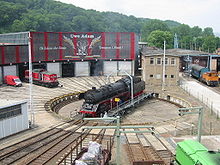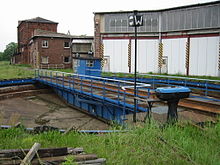Eisenach depot
The Eisenach depot (abbreviated: Bw Eisenach ) is a depot that has existed since 1847 (since 1926 at the current location “Räuberloch”). The old systems are located directly at Eisenach train station and were put into operation at the same time in 1847. The first structures consisted of a locomotive hall with two tracks, turntable and a water station. Between 1922 and 1926, a larger new building was built on a site east of the Eisenach train station.
history
The Thuringian Railway Company (ThEG) put the Gotha - Eisenach section into operation on June 24, 1847 . This meant that Eisenach was initially the terminus of the Thuringian trunk line , which was planned to continue to Gerstungen . On November 25, 1849, the Eisenach – Gerstungen section was connected to the network of the Hessian Friedrich-Wilhelms-Nordbahn-Gesellschaft . In 1858 the Werra Railway Eisenach - Meiningen - Coburg started operating .
This means that Eisenach station had grown into a sizable railway junction very early on. After the turn of the century , the Wartha - Treffurt and Wutha - Ruhla lines were built and their integration into the Thuringian trunk line near Eisenach.
The original systems were located directly at the train station on the site of the now abandoned rail vehicle works on Langensalzaer Straße, which is only used as a storage group. While the ThEG carried out repairs and inspections of their vehicles in the central workshop in Erfurt , the maintenance workshop in Eisenach was responsible for ongoing maintenance.
When the Eisenach plants were no longer able to cope with the increased volume of traffic, the train station was rebuilt between 1871 and 1873 and a new roundhouse with a turntable was built at the old location in the city. The building of the roundhouse is still there today and can be seen from platform 6. Because an expansion of the depot in the inner city area was not spatially possible, a completely new depot with roundhouse, 27-m turntable, wagon hall and administration and ancillary buildings was built east of the freight station in the so-called "Räuberloch" between 1922 and 1926 . Between 1974 and 1980 these systems were also completely rebuilt. The old, dark roundhouse had to give way to a modern, 20-person steel and glass construction with seven workshop tracks for the heavy maintenance of large diesel locomotives. A five-story social building, a new heating plant and a large tank system were also built. The training workshop and the material warehouse have also been modernized. A car wash was built later.
The German Bahn AG has sold the plant in 2004 after the closure of the railway operations work Eisenach 1994th The entire property at the "Räuberloch" is now owned by the Uwe Adam group . The site was largely cleaned up by the new owner. The old coal bans and large parts of the elevated district heating pipes had already disappeared by 2007. Since the DBAG moved out, the social building and the administration building together with the water tower had also been empty and were demolished in May 2009. The former lignite heating plant now houses a disposal company and the adjacent vehicle garages , in which the company fire brigade was also located, is now used by an association for the preservation of historic IFA commercial vehicles.
The locomotive shed and the core area will continue to be actively used by Uwe Adam Eisenbahnverkehrsunternehmen GmbH as a depot for maintenance and repair work on rail vehicles. In recent years, the engine shed and workshop area has been energetically renovated , modernized and additional specialist staff have been hired. A large locomotive manufacturer and many railway companies are increasingly using the conveniently located location for the maintenance, cleaning and repair of their rail vehicles. In 2019 the 27m turntable was completely renovated. An expansion of the technical systems for heavy maintenance is planned.
The workshop of the IGE Werrabahn Eisenach eV is located in the former wagon hall . In addition to some wagons and special vehicles, the vehicle inventory of the association, which was founded in 1986, includes the operational steam locomotives 41 1144 and 52 1360. A former Eisenacher LVT 2.09 (772 149, 972 749), which is privately owned, is also located there. There is no museum operation.
Major agency
On April 1, 1974, the Deutsche Reichsbahn restructured the Eisenach depot into a major service center. The former Bahnbetriebswerke Gotha and Vacha were dissolved as independent offices and continued as depots of the Eisenach depot. As early as 1952, the DR dissolved the Gerstungen depot, which had been independent until then, and assigned it to the Eisenach depot. Repairs to rail vehicles continued to be carried out in Vacha and Gotha. While the Gotha operation center specialized in DR class 171 and 172 multiple units and diesel locomotives up to the DR class 110 and 112 , the Eisenach service center was responsible for the maintenance and repair of all large diesel locomotives and the shunting locomotives used in Eisenach. Extensive technical systems were available for this (crane systems, axle recess, oil change and separation system, washing system and cleaning framework). At the Vacha site, maintenance and repair work was also carried out on shunting and large diesel locomotives, for which all the necessary technical systems were also available. The Eisenach depot, with its systems for the steam locomotive supply that were still in existence at the time, served as a turning and delivery point for trial and delivery trips to the Meiningen raw material . The locomotive depots or train stations Gerstungen , Mühlhausen and Bad Tennstedt and the two locomotive locations were only used to house locally required locomotives and railcars.
Branch offices of the Bw Eisenach:
- Operation site Gotha
- Mission Vacha
- Locomotive deployment point Gerstungen
- Locomotive service station Mühlhausen
- Locomotive service station Bad Tennstedt
- Locomotive location Bad Langensalza
- Locomotive location Bad Salzungen
- Steel construction Vacha
Vehicle inventory
The first locomotives based in Eisenach were procured from the English locomotive factory George Stephenson and from Berlin August Borsig when they started operating . In order to cope with the constantly increasing volume of traffic, the first three-coupler (C wheel arrangement) were purchased in 1868. With the takeover of ThEG by the Prussian State Railways on July 1, 1886, Prussian P 2 , P 3 and P 4 and P 4.2 as well as goods locomotives of the classes G 3 , G 4.2 , G 7.1 and G 7.2 took over the train transport. The shunting service was done by small type T 3 tank locomotives .
After the turn of the century, mainly Prussian P 8 (series 38), P 10 (series 39) and G 12 (series 58) could be found in Eisenach . The latter machines were completely replaced by the 43 series by the end of the Second World War . The number of 39 locomotives rose to 12, so that in 1945 there were a total of 39 locomotives in Eisenach. The inventory changed little until 1965. The series 38, 39, 43, 44, 55, 57, 58 were still at home. Class 93 and 94 locomotives operated and shunted the branch lines. In 1964, the Eisenach depot was assigned the first diesel locomotive , V 60 1242 . In addition to the series already mentioned, in 1965 there were also eight series 41 locomotives in a total of 44 locomotives. In the years that followed, diesel locomotives of the V 60, V 180 and V 200 series were increasingly allocated . In 1971, scheduled steam operation in the Eisenach depot ended. This very early point in time for the Deutsche Reichsbahn is to be seen in connection with the increasing potash transports, the proximity of the inner-German border and the operational processes of the Gerstungen border station . After the establishment of the large service center, the number of locomotives grew to 125 locomotives. In the meantime, all of the diesel locomotive series used by the DR at that time were on the inventory list. The last steam locomotives used as heating locomotives were still available until 1979 as 41 1200, 95 0010 and 95 0045. Later machines of the 44 series were again stationed as "provisional mobile heating systems". The agency achieved the highest number of locomotives in 1991 with 149 locomotives.
In the above list, however, railcars were not taken into account. These were always based at the Gotha deployment site.
Personnel deployment
There is almost no information about the personnel situation in the early years up to the end of the Second World War. The personnel situation at the Deutsche Reichsbahn was tense from the beginning over the entire period of its existence. For this reason, at the beginning of the school year in 1947, the railway depot began training apprentices in order to attract young talent. Two rooms were prepared for this early on. In 1950, the Eisenach railway workers took a barrack they had built themselves into operation, thereby improving training opportunities. In 1980 a completely new training workshop was inaugurated, in which vehicle fitters and locomotive electricians received training. A computer cabinet later even added to this facility. Also the implementation of the class day in production (UTP) , which is usual in the GDR school education , from the 7th grade onwards could now be carried out here. The public education department of the Eisenach district concluded corresponding contracts with the depot.
The major agency had the highest workforce in 1987 with a total of 1,052 employees and 92 apprentices (trainees). When Deutsche Bahn AG was founded in 1994, the workforce had already shrunk to 523 employees.
literature
- Georg Thielmann, Eberhard Krauss, Rudolf Spitschan: Bw Eisenach: past and present of a traditional railway depot . 1st edition. Wachsenburgverlag, Arnstadt 2007, ISBN 978-3-935795-14-2 .
See also
Web links
Coordinates: 50 ° 58 ′ 6 ″ N , 10 ° 20 ′ 56 ″ E



